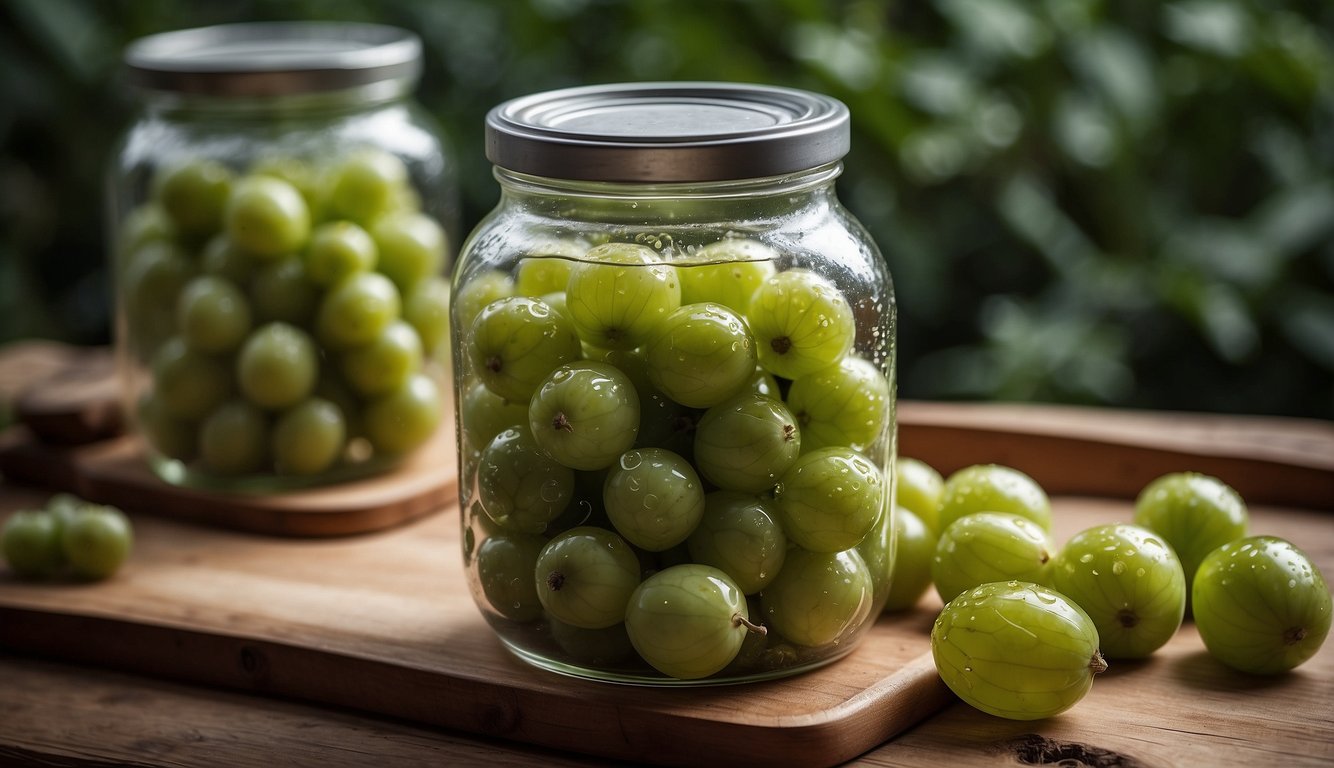TheHerbProf.com is a treasure trove of knowledge for those interested in natural healing and herbal remedies. The website is run by Paul Johnston MD. A naturopathic who has not only received extensive education in the field but also has personal experience in self-healing.
Fermented cucamelons, also known as Mexican sour gherkins or mouse melons, are a unique and delicious addition to any diet. These tiny fruits are about the size of a grape, with a flavor that is similar to a cucumber with a hint of sourness. The fermentation process gives them a tangy, complex flavor that is both refreshing and satisfying.
Fermentation has been used for centuries as a way to preserve food and enhance its nutritional value. Fermented foods are rich in probiotics, which are beneficial bacteria that can improve digestion, boost the immune system, and promote overall health. Fermented cucamelons are a great way to incorporate these health benefits into your diet in a delicious and easy way. Plus, they are incredibly easy to make at home with just a few simple ingredients.
Understanding Fermented Cucamelons
What Are Cucamelons
Cucamelons, also known as Mexican Sour Gherkins, are a tiny, grape-sized vegetable that is native to Mexico and Central America. They look like miniature watermelons and have a slightly sour taste that is similar to cucumbers. Cucamelons are often used in salads, pickles, and salsas. They are also rich in antioxidants, vitamins, and minerals.
Nutritional Profile
Cucamelons are a low-calorie, nutrient-dense vegetable that is packed with vitamins and minerals. According to healthline.com, one cup (132 grams) of cucamelons contains:
- Calories: 39
- Protein: 1 gram
- Fat: 0 grams
- Carbohydrates: 9 grams
- Fiber: 2 grams
- Vitamin C: 10% of the Daily Value (DV)
- Vitamin K: 9% of the DV
- Calcium: 2% of the DV
- Iron: 3% of the DV
- Magnesium: 6% of the DV
Fermented cucamelons are also a great source of healthy probiotics. They are rich in lactic acid bacteria, which are beneficial for gut health. This makes them an excellent addition to any diet, especially for those looking to improve their digestive health.
Overall, cucamelons are a tasty and nutritious vegetable that can be enjoyed in a variety of ways. Fermenting them is an excellent way to preserve their flavor and nutritional value while also adding beneficial probiotics to your diet.
The Basics of Fermentation
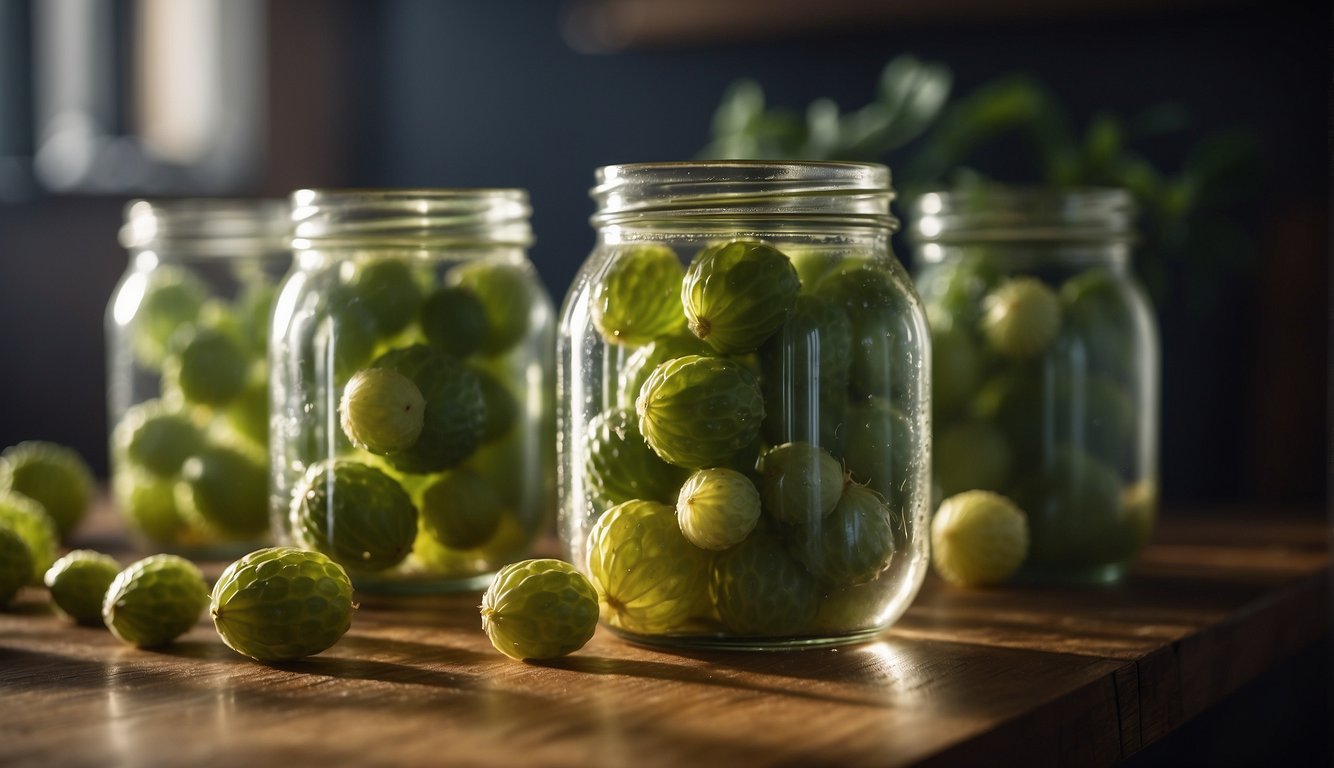
As a food preservation technique, fermentation has been around for centuries. It is a natural process that involves the breakdown of sugars and carbohydrates by microorganisms such as bacteria, yeasts, and molds. The result is the production of lactic acid, alcohol, and other compounds that give fermented foods their unique flavor, texture, and nutritional benefits.
Fermentation Process
The fermentation process requires a few basic ingredients: the food to be fermented, salt, and water. The salt acts as a natural preservative and inhibits the growth of harmful bacteria, while the water creates an anaerobic environment that encourages the growth of beneficial bacteria.
To start the fermentation process, the food is submerged in a saltwater brine and left to sit at room temperature for several days or weeks. During this time, the beneficial bacteria consume the sugars and carbohydrates in the food, producing lactic acid and other compounds that preserve the food and give it its distinctive flavor.
Lacto-Fermentation Explained
Lacto-fermentation is a specific type of fermentation that involves the use of lactic acid bacteria. These bacteria convert sugars and carbohydrates into lactic acid, which gives fermented foods their tangy flavor and helps to preserve them.
When it comes to making fermented pickles or fermented cucumbers, lacto-fermentation is the preferred method. The cucumbers are submerged in a saltwater brine along with garlic, dill, and other flavorings, and left to ferment for several days. During this time, the lactobacillus bacteria consume the sugars in the cucumbers, producing lactic acid and other compounds that give the pickles their sour, tangy flavor.
Overall, fermentation is a simple and effective way to preserve food and enhance its flavor and nutritional value. By harnessing the power of beneficial bacteria, we can create delicious and healthy foods that are packed with probiotics and other beneficial nutrients.
Required Ingredients and Equipment
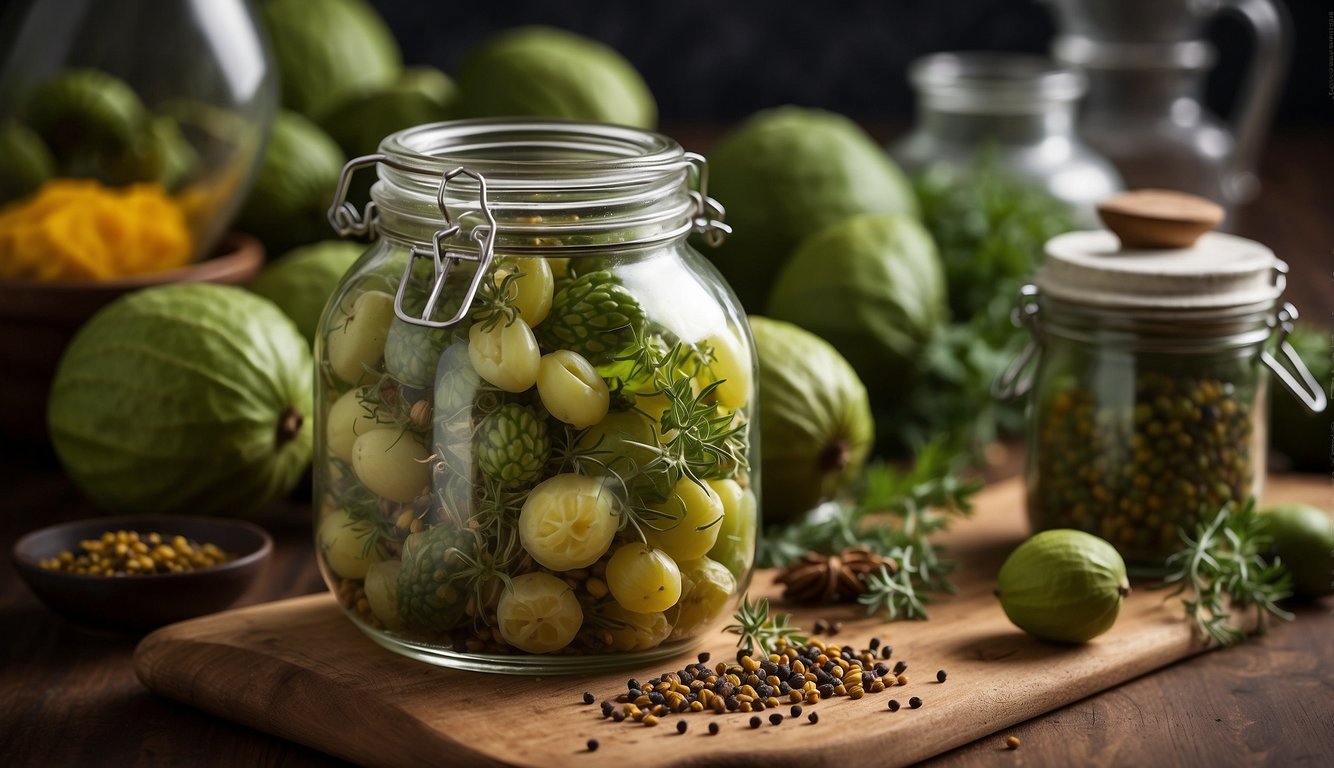
Choosing the Right Ingredients
When making fermented cucamelons, it is important to choose fresh and high-quality ingredients. Here are the ingredients you will need:
- Cucamelons: Make sure to choose cucamelons that are firm and free from any signs of spoilage or damage.
- Dill: This herb is an essential ingredient in making pickles. Choose fresh dill for the best flavor.
- Garlic: Use fresh garlic cloves for added flavor.
- Salt: Use non-iodized salt or pickling salt. Sea salt can also be used.
- Spices: Mustard seeds, coriander seeds, and allspice are commonly used in making pickles.
- Vinegar (optional): Vinegar can be added to the brine for added tanginess.
Essential Fermenting Equipment
To make fermented cucamelons, you will need the following equipment:
- Mason jar: Use a glass mason jar to ferment the cucamelons.
- Fermentation weight: This weight is used to keep the cucamelons submerged in the brine.
- Airlock lid: This lid allows gases to escape while preventing air from entering the jar.
- Kitchen scale: A kitchen scale is useful for measuring the ingredients accurately.
Make sure to sanitize all equipment before use to prevent contamination.
Preparing Your Cucamelons
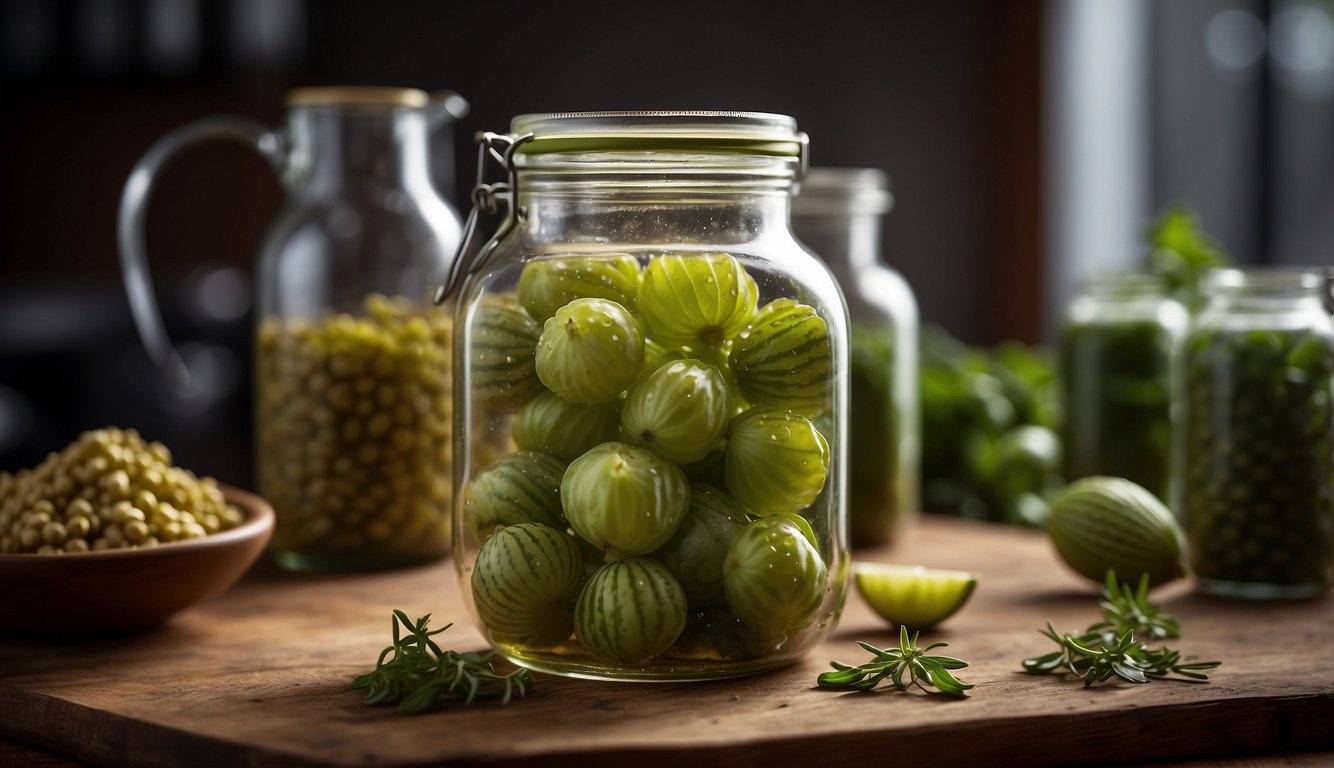
As with any homemade pickling project, preparing your cucamelons is an essential step towards achieving a delicious end product. In this section, I will guide you through the necessary steps to ensure that your cucamelons are clean, prepped, and ready for pickling.
Cleaning and Prepping
Before anything else, it is important to clean your cucamelons thoroughly. Rinse them in cold water, and gently scrub them with a soft-bristled brush. This will help remove any dirt or debris that may be stuck to the surface of the cucamelons. Once they are clean, pat them dry with a clean towel.
If you are using grape leaves to help keep your cucamelons crisp, make sure to rinse them as well. Grape leaves contain tannins that can help keep your cucamelons firm during the pickling process.
Slicing and Dicing Techniques
When it comes to slicing and dicing your cucamelons, there are a few techniques you can use. You can slice them in half, quarter them, or leave them whole. The choice is yours, and it will depend on your personal preference and the size of your cucamelons.
If you prefer your pickles to have a bit of crunch, slice your cucamelons in half or quarter them. This will expose more surface area to the pickling liquid, allowing it to penetrate the cucamelons more easily.
On the other hand, if you prefer your pickles to be a bit softer, leave your cucamelons whole. This will help them retain their shape and texture during the pickling process.
Overall, the key to preparing your cucamelons is to make sure they are clean, prepped, and ready for pickling. By following these simple steps, you can ensure that your homemade pickles will turn out delicious every time!
Creating the Perfect Brine
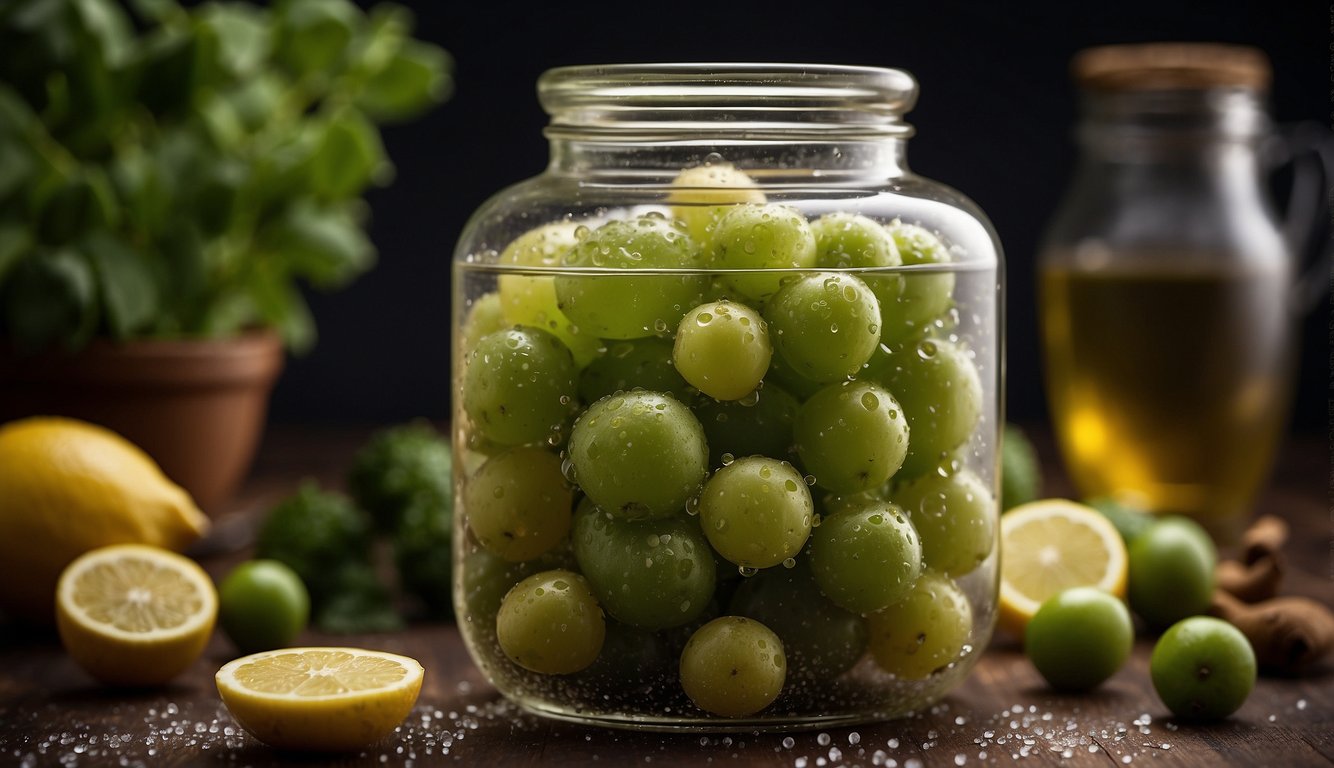
As a fermented cucamelon enthusiast, I know that the perfect brine is crucial for the success of any pickle recipe. In this section, I will share my knowledge and experience on how to create the perfect brine for your fermented cucamelons.
Brine Ratios and Mixtures
The first step in creating the perfect brine is to choose the right ratio of salt to water. A general rule of thumb is to use a 3-5% saltwater brine solution. For a milder pickle, use a 3% solution, while a stronger and saltier pickle requires a 5% solution. I recommend using a food scale to measure the salt accurately.
Aside from salt, you can mix in other spices and flavorings to create a unique and tasty brine. Some popular spices for fermented cucamelons include dill, mustard seed, peppercorns, coriander seeds, allspice, and dill seeds. Yellow mustard seeds are also a great addition to the brine, as they add a tangy flavor to the pickles.
Adding Spices and Flavorings – Fermented Cucamelons
To add spices and flavorings to the brine, you can either add them directly to the brine solution or place them in a spice bag. Placing the spices in a spice bag makes it easier to remove them after fermentation.
When adding spices to the brine, it’s important to use fresh and high-quality ingredients. You can experiment with different spice combinations to create unique and flavorful pickles. For example, adding fresh garlic and bay leaves to the brine can give your pickles a savory and aromatic flavor.
In conclusion, creating the perfect brine for fermented cucamelons requires a balance of salt and spices. By following the right brine ratios and mixing in your preferred spices and flavorings, you can create delicious and healthy pickles that are perfect for snacking or adding to your favorite dishes.
Fermentation Process

Fermenting cucamelons is a simple process that requires just a few ingredients and tools. The fermentation process is initiated by the Lactobacillus bacteria naturally present on the cucamelons. This bacteria feeds on the natural sugars present in the cucamelons and converts them into lactic acid, which gives the pickles their characteristic tangy flavor.
Monitoring Fermentation – Fermented Cucamelons
During the fermentation process, it is important to monitor the cucamelons daily to ensure that they are fermenting properly. The cucamelons should be submerged in the brine at all times to prevent mold growth. If mold does appear, it is best to discard the entire batch and start over.
Another important thing to monitor is the effervescence or fizzy brine. This is a sign that the fermentation process is active and ongoing. If there is no effervescence, it could mean that the fermentation process has stalled, and the cucamelons may not be safe to eat.
Determining Fermentation Time
The fermentation time for cucamelons can vary depending on several factors, such as the temperature, the size of the cucamelons, and the amount of salt used. Generally, cucamelons take anywhere from 3 to 10 days to ferment.
To determine if the cucamelons are ready, taste them daily starting from the third day. When they have reached the desired level of tanginess, transfer them to the refrigerator to slow down the fermentation process.
In conclusion, fermenting cucamelons is an easy and rewarding process that yields delicious pickles. By monitoring the fermentation process and determining the fermentation time, you can ensure that your cucamelons turn out perfectly every time.
Flavoring and Seasoning – Fermented Cucamelons
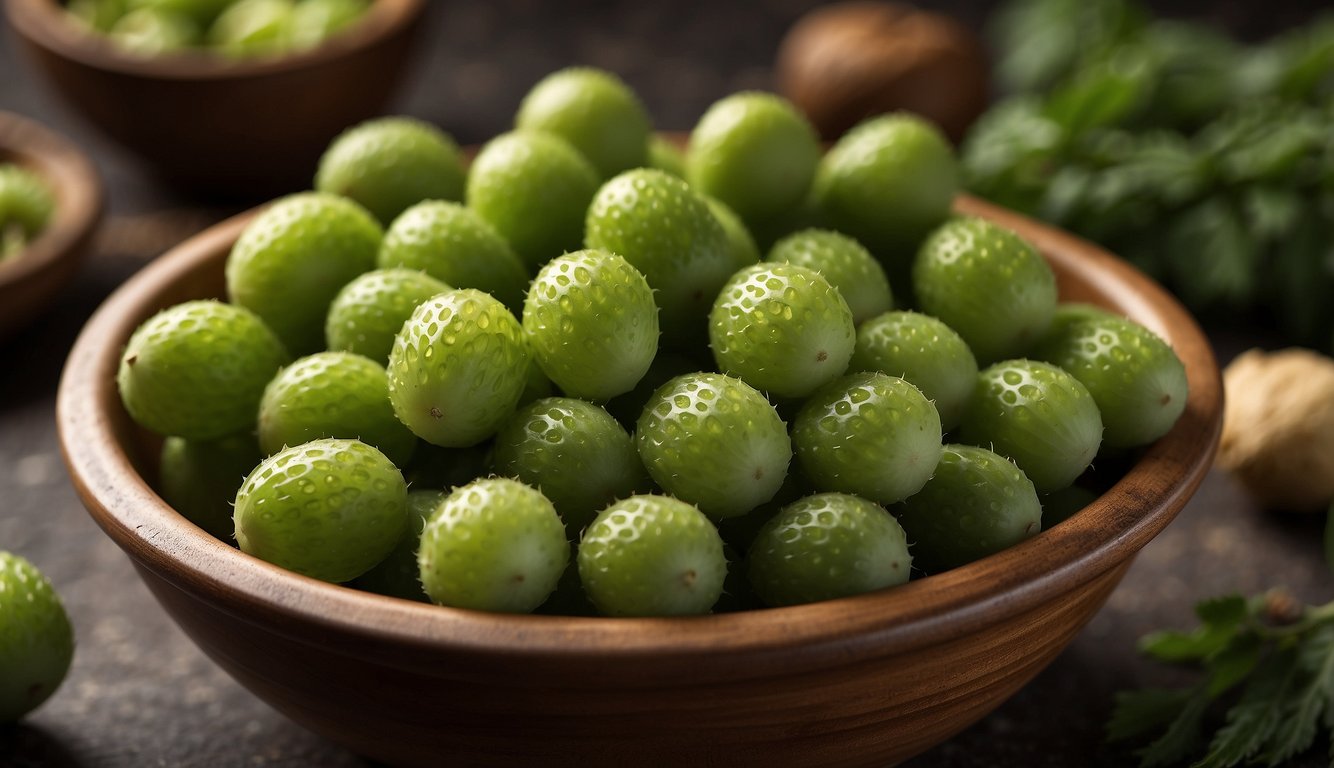
When it comes to flavoring and seasoning your fermented cucamelons, the possibilities are endless. Here are some herbs and spices to consider:
Herbs and Spices to Consider – Fermented Cucamelons
- Garlic cloves: Garlic is a great addition to any fermented vegetable recipe, and cucamelons are no exception. It adds a pungent, savory flavor that complements the tanginess of the cucamelons.
- Fresh dill: Dill is a classic herb for pickling, and it works just as well for fermented cucamelons. Use fresh dill flowers, stems, and leaves to add a bright, herbaceous flavor.
- Dill seed: If you don’t have fresh dill on hand, you can also use dill seed. It has a similar flavor to fresh dill and adds a nice crunch to the finished pickles.
- Mustard seeds: Mustard seeds are a great addition to fermented cucamelons. They add a subtle heat and a pop of texture.
- Fennel: Fennel is a flavorful herb that pairs well with cucamelons. Use the fronds and seeds to add a licorice-like flavor.
- Basil: Basil is another herb that works well with fermented cucamelons. It adds a sweet, slightly spicy flavor that complements the tanginess of the cucamelons.
- Turmeric: Turmeric adds a bright yellow color and a mild, slightly bitter flavor to fermented cucamelons.
- Fennel seeds: Fennel seeds have a similar flavor to fennel fronds and add a nice crunch to the finished pickles.
- Celery seeds: Celery seeds add a subtle celery flavor and a pop of texture to fermented cucamelons.
- Bay leaves: Bay leaves add a subtle, earthy flavor to fermented cucamelons.
- Red pepper flakes: If you like your pickles spicy, add some red pepper flakes to the mix. They add a nice kick of heat.
Personalizing Your Ferment
Don’t be afraid to experiment with your own flavor combinations. Try adding different herbs and spices to see what works best for you. You can also adjust the amount of salt you use to control the level of fermentation. Just remember to keep track of what you add so you can recreate your favorite flavors in future batches.
Storing Fermented Cucamelons
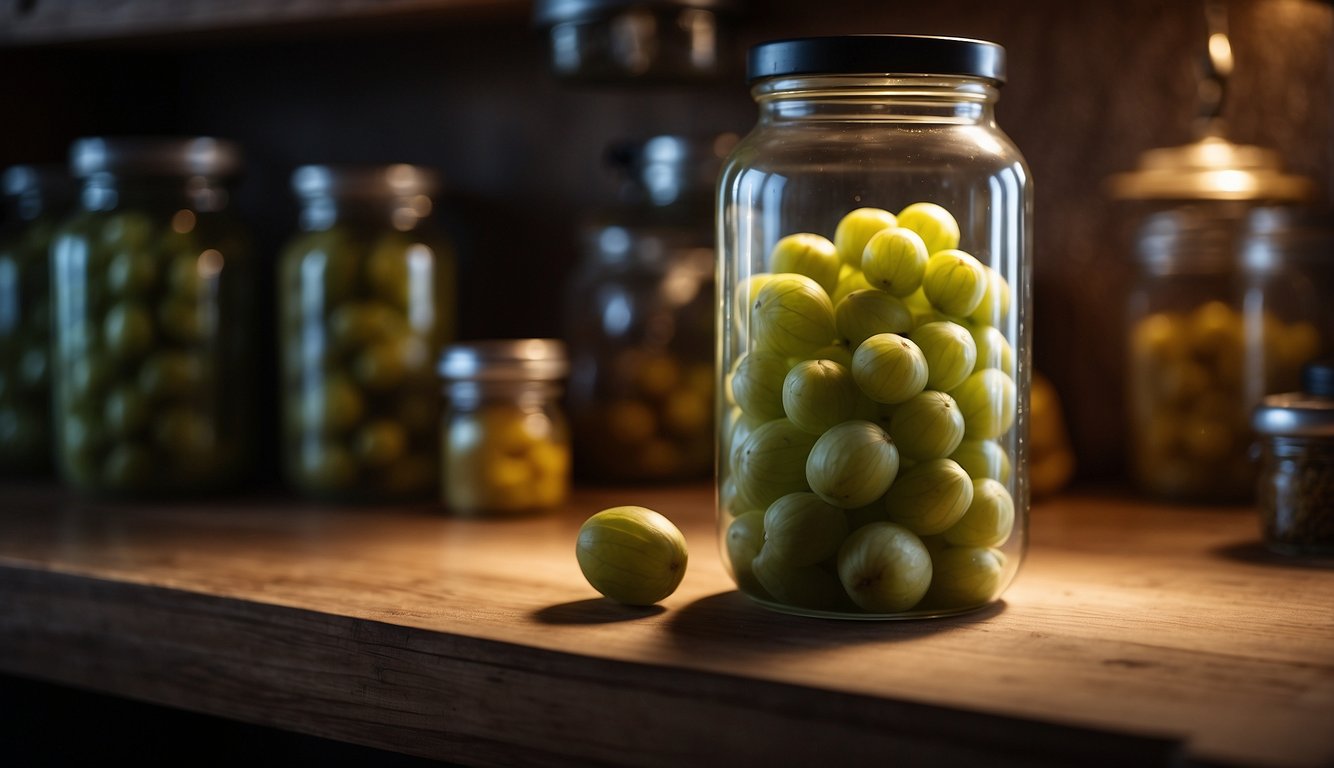
As a fan of fermented cucamelons, I know how important it is to store them properly to maintain their flavor and quality. In this section, I will discuss the best ways to store fermented cucamelons for short-term and long-term storage.
Refrigeration and Shelf Life – Fermented Cucamelons
Fermented cucamelons should be stored in the refrigerator or a cold room to stop the fermentation process. This will help maintain their flavor and quality. Fermented cucamelons can last for up to 3 months in the refrigerator.
It is important to note that the longer fermented cucamelons are stored, the softer they become. This is because the fermentation process continues even in the refrigerator, albeit at a slower pace. If you prefer crunchier cucamelons, it is best to consume them within the first few weeks of fermentation.
Packaging for Long-Term Storage
If you want to store fermented cucamelons for longer than 3 months, you can package them for long-term storage. The best way to do this is by using canning jars or glass containers with air-tight lids. It is important to sterilize the jars or containers before use to prevent contamination.
Once the jars or containers are sterilized, fill them with the fermented cucamelons, leaving about an inch of headspace. Cover the cucamelons with the brine from the fermentation process, making sure they are completely submerged. Seal the jars or containers tightly and store them in a cool, dark place such as a pantry or cellar.
When properly packaged, fermented cucamelons can last for up to 6 months in a cool, dark place. However, it is important to regularly check the jars or containers for any signs of spoilage such as mold or off smells. If you notice any signs of spoilage, discard the cucamelons immediately.
Overall, storing fermented cucamelons is easy as long as you follow these simple guidelines. By refrigerating them for short-term storage and packaging them properly for long-term storage, you can enjoy the delicious flavor of fermented cucamelons for months to come.
Safety and Troubleshooting – Fermented Cucamelons
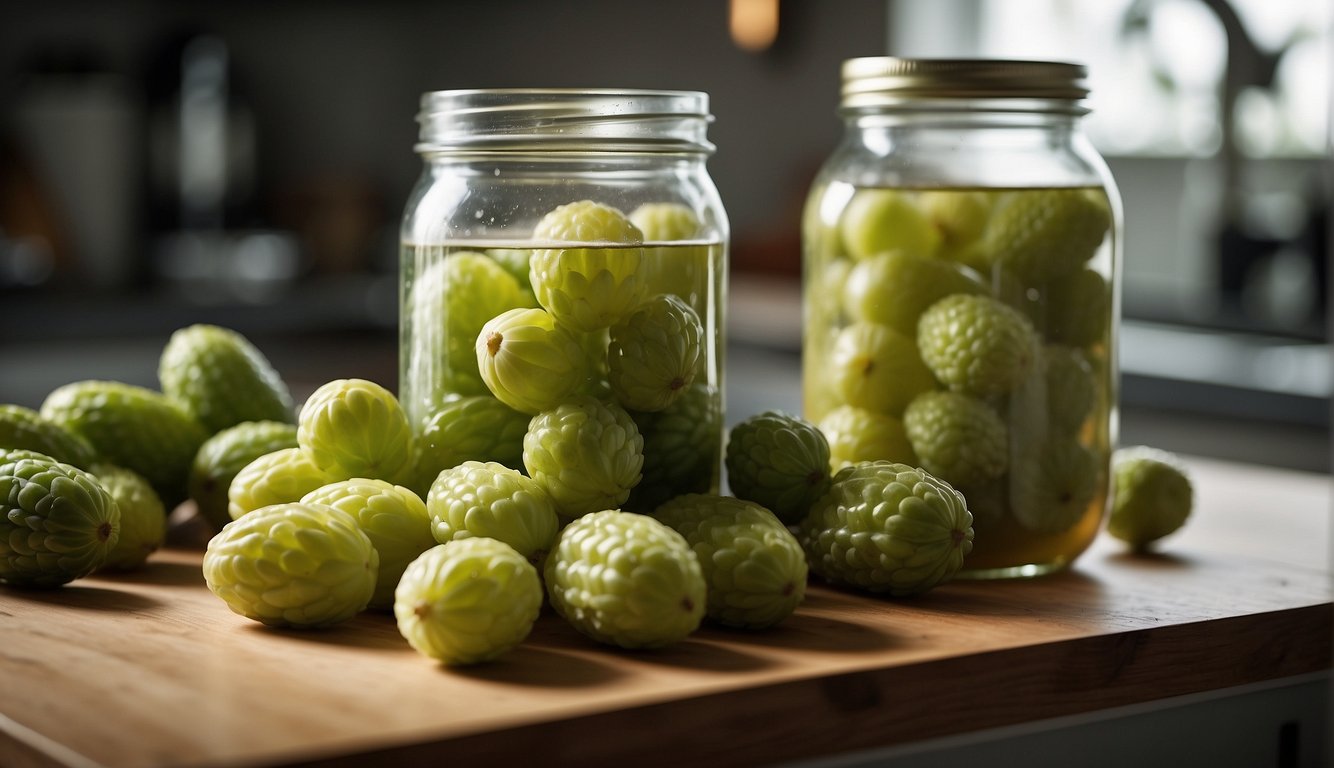
As with any fermentation process, safety is a top priority when fermenting cucamelons. Here are some tips to ensure that your fermented cucamelons are safe to consume.
Identifying and Preventing Mold – Fermented Cucamelons
Mold is a common issue that can occur during the fermentation process. It can be identified by its fuzzy appearance and unpleasant smell. While some molds are harmless, others can produce mycotoxins that can be harmful to human health. To prevent mold growth, ensure that your cucamelons are fully submerged in the brine and that there is no exposure to air. Additionally, make sure that all equipment used in the fermentation process is clean and sanitized.
Dealing with Common Issues
Botulism is a rare but serious form of food poisoning that can occur during the fermentation process. It is caused by the Clostridium botulinum bacteria, which can produce a deadly toxin in the absence of oxygen. To prevent botulism, ensure that your cucamelons are fully submerged in the brine and that the brine has a sufficient salt concentration. It is also important to use fresh, high-quality ingredients and to follow a research-based recipe.
If you encounter any issues during the fermentation process, such as off flavors or unpleasant odors, there are a few troubleshooting steps you can take. First, ensure that your equipment is clean and that your cucamelons are fully submerged in the brine. Additionally, make sure that your brine has a sufficient salt concentration and that you are using fresh, high-quality ingredients. Finally, if all else fails, don’t be afraid to discard the batch and start over. It’s better to be safe than sorry when it comes to food safety.
Serving Suggestions – Fermented Cucamelons
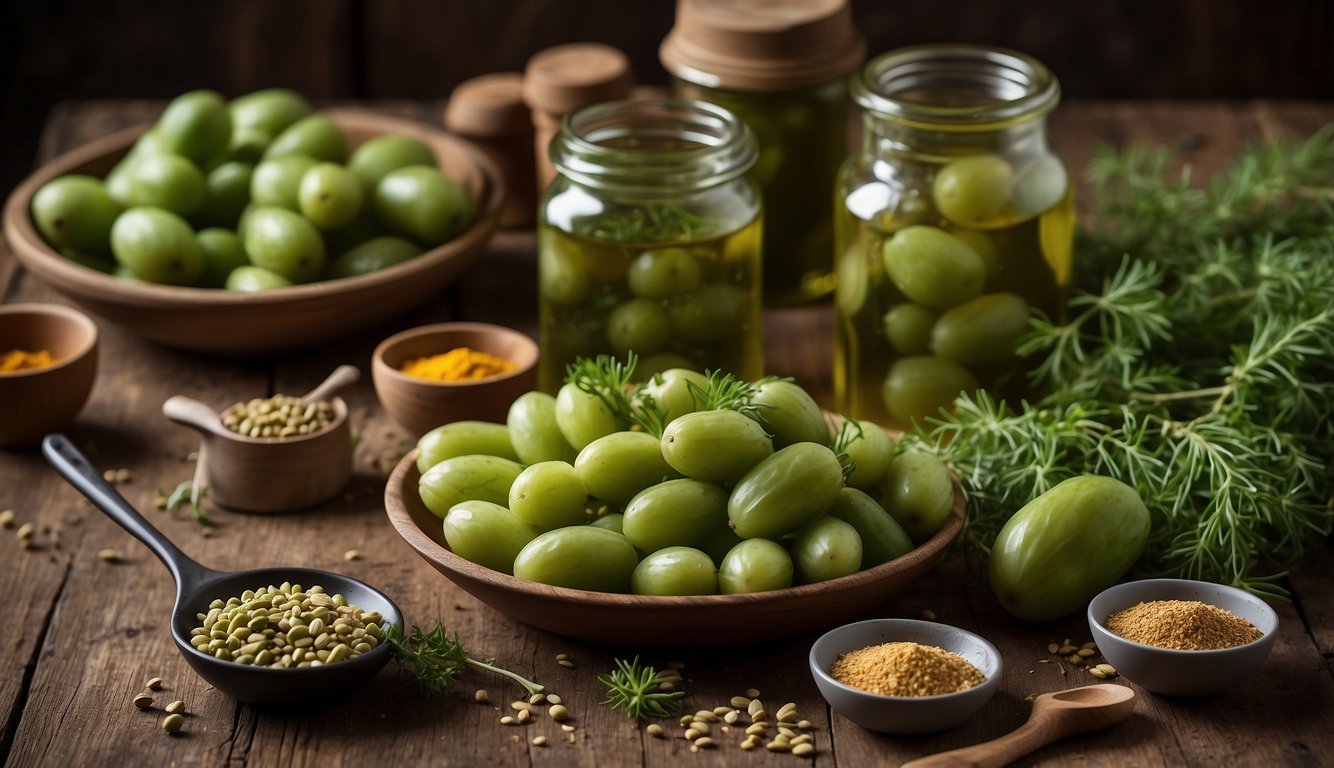
Pairings and Recipes
When it comes to serving fermented cucamelons, there are plenty of options to choose from. These pickles pair well with a variety of dishes and can be used in many recipes. Here are a few ideas to get you started:
- Burgers: Fermented cucamelons make a great addition to burgers. They add a nice crunch and tangy flavor that complements the savory meat and toppings. Try adding them to your favorite burger recipe for a tasty twist.
- Tasting Platter: If you want to showcase the unique flavor of fermented cucamelons, try serving them on a tasting platter with other pickled vegetables and cheeses. This is a great way to let the cucamelons shine and allow people to try them on their own.
- Salads: Fermented cucamelons can add a nice crunch and tangy flavor to salads. Try adding them to a mixed greens salad with a light vinaigrette for a refreshing summer dish.
- Sandwiches: Fermented cucamelons can be used in place of traditional pickles on sandwiches. They add a unique flavor and texture that can elevate your sandwich game.
Creative Uses in Meals
In addition to pairing well with other foods, fermented cucamelons can also be used creatively in meals. Here are a few ideas:
- Fermented Pickles Recipe: If you’re feeling adventurous, try making your own fermented cucamelon pickles. This recipe from Julia Dimakos is a great place to start. You can adjust the spices and seasonings to your personal preference and experiment with different flavors.
- Kirby Cucumbers Substitute: If you can’t find cucamelons, you can use Kirby cucumbers as a substitute in recipes. They have a similar size and texture and can be pickled in the same way.
- Personal Preference: Ultimately, how you use fermented cucamelons is up to your personal preference. Don’t be afraid to experiment and try them in different ways. They can add a unique twist to many dishes and are a fun ingredient to play around with.
Fermented Cucamelons
Today, we’re diving into the tangy world of fermented cucamelons. Yes, those tiny, cucumber-like fruits can be fermented, and boy, are they tasty!
Firstly, let’s talk about cucamelons. They’re small, they’re crunchy, and they have a delightful cucumber-like taste with a hint of sourness. Perfect for fermenting!
Now, the fermentation process. It’s simple, really. All you need is some water, salt, and a jar. Pop the cucamelons in, add the brine, and let nature do its thing!
And here’s the best part! Fermented cucamelons are not just tasty, they’re also packed with probiotics. Good for the gut, and good for the soul!
So, why not give fermented cucamelons a try? They’re a fun, healthy addition to your diet.
For more fermentation adventures, do visit the website theherbprof.com. Keep it tangy, folks!
References – Fermented Cucamelons
Little Herb Encyclopedia, by Jack Ritchason; N.D., Woodland Publishing Incorporated, 1995
The Ultimate Healing System, Course Manual, Copyright 1985, Don Lepore
Planetary Herbology, Michael Tierra, C.A., N.D., Lotus Press, 1988
Handbook of Medicinal Herbs, by James A. Duke, Pub. CRP Second Edition 2007
The Complete Medicinal Herbal, by Penelope Ody, Published by Dorling Kindersley
Check the Following Articles!
Tomato Water Wilt: Causes and Solutions
Grow Carrots from Tops: A Simple Guide
How to Grow Moss Indoors: A Beginner’s Guide
Frequently Asked Questions – Fermented Cucamelons
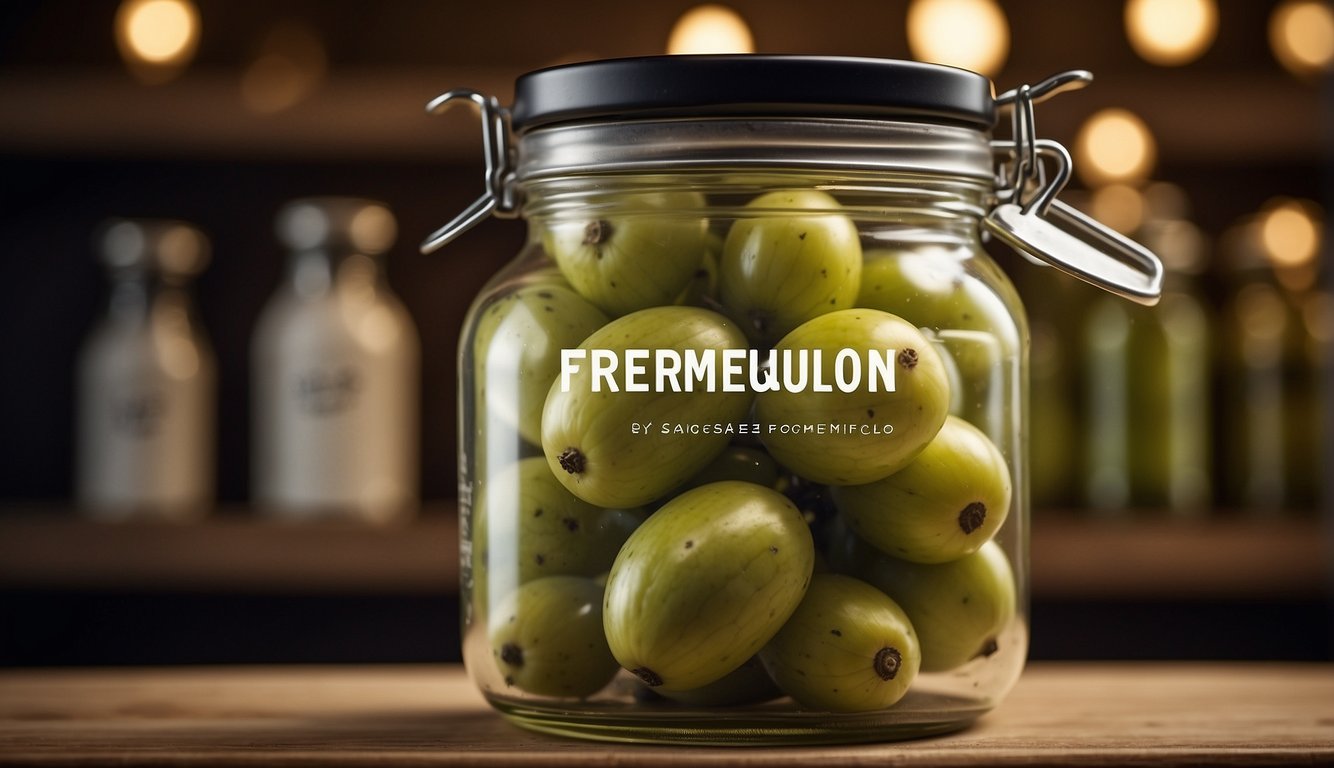
What are some popular recipes for fermenting cucamelons?
There are several popular recipes for fermenting cucamelons. One recipe involves using garlic, pickling spice, dill fronds, and bay leaves. Another recipe includes using salt, water, garlic, and dill. You can also add other herbs and spices to customize the flavor to your liking.
How can cucamelons be incorporated into salads?
Cucamelons can be a great addition to salads. You can slice them in half and add them to a mixed greens salad for a refreshing crunch. They also pair well with feta cheese, cherry tomatoes, and balsamic vinaigrette.
What is the process for making bread and butter fermented cucamelons?
To make bread and butter fermented cucamelons, you will need cucamelons, onions, turmeric, mustard seeds, and apple cider vinegar. Slice the cucamelons and onions and place them in a jar. Mix the turmeric and mustard seeds in a bowl and sprinkle over the cucamelons and onions. Pour in the apple cider vinegar and let ferment for several days.
Can cucamelons be used in making alcoholic beverages like gin?
Cucamelons can be used in making gin. They add a unique flavor to the gin that is both sweet and sour. To make gin with cucamelons, you will need to infuse the cucamelons in the gin for several days.
What are the signs of safe fermentation in pickled cucamelons?
Signs of safe fermentation in pickled cucamelons include a sour smell and taste, a cloudy brine, and bubbles. If you notice any mold or an off smell, discard the cucamelons.
What is the recommended fermentation time for cucamelons to achieve optimal flavor?
The recommended fermentation time for cucamelons is typically between 3 and 7 days. However, the optimal fermentation time can vary depending on the recipe and personal preference.
